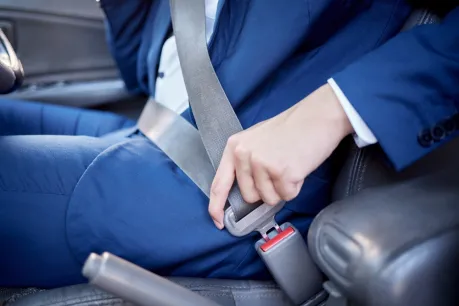How Seat Belts and Car Seats Work Together to Protect Your Family

Injured?
As a parent, ensuring your child’s safety on the road is non-negotiable. Whether you're embarking on a road trip or just running errands around town, the combination of seat belts and car seats serves as a dynamic duo in protecting your most precious cargo. But how exactly do these two safety systems work together to provide maximum protection?
Below, we’ll dive into the critical relationship between seat belts and car seats, and why both are necessary for keeping your family safe.
Why Are Seatbelts Important?
Seat belts have been around since the 1950s and are often seen as the cornerstone of car safety. For adults and older children, seat belts help distribute the force of a crash across the strongest parts of the body, reducing the risk of serious injury or death. They work by keeping you in place and preventing you from being thrown around the car or ejected in the event of an accident.
However, for younger children and infants, seat belts alone aren’t enough. This is where car seats come into play. Car seats are specifically designed to accommodate a child’s smaller size and provide the extra protection they need. But without seat belts, car seats wouldn’t be able to function effectively.
How Can Car Seats and Seat Belts Work in Tandem?
When it comes to child safety, car seats and seat belts aren’t competing technologies—they’re partners in protection.
In most vehicles, seat belts are used to secure the car seat itself to the car. Whether you're using a rear-facing infant seat or a forward-facing car seat, the seat belt is threaded through designated slots to lock the car seat into place. This prevents the seat from moving or shifting in the event of a crash.
A properly installed car seat is only as secure as the seat belt holding it. Seat belts provide the necessary tension to keep the car seat in place. Many modern car seats also have a lock-off device that works with the seat belt to ensure the seat stays tight and secure.
Once the car seat is properly installed, the seat belt’s role shifts to supporting the car seat’s internal harness system. Car seats come equipped with their own harnesses, designed to keep the child securely strapped in. The seat belt ensures the car seat doesn’t move, allowing the car seat’s harness to protect the child from impact.
In the event of a collision, both the seat belt and the car seat’s harness distribute the crash forces in a way that minimizes injury. The seat belt stabilizes the car seat, while the car seat’s harness spreads the crash forces across the child’s body, protecting their head, neck, and spine.
Car Seat Installation 101
Here’s where it can get tricky—car seat installation is not as easy as it looks. According to the National Highway Traffic Safety Administration (NHTSA), nearly 59% of car seats are misused or incorrectly installed. Here’s how to ensure your car seat is safely and securely installed.
- Read the Manual: Both your car seat and your vehicle’s owner manual come with important information on installation. Every car seat and car model is a little different, so always refer to these guides first.
- Use the Seat Belt or LATCH System, Not Both: Most car seats can be installed using either the seat belt or the LATCH (Lower Anchors and Tethers for Children) system. However, using both at the same time is not recommended. Choose one system for a safe and secure installation.
- Check the Angle: Many infant car seats have built-in angle indicators to ensure they’re positioned correctly. Keep an eye on this when installing to prevent your baby’s head from tilting forward.
- The Inch Test: After installation, try moving the car seat side to side and front to back. If it moves more than one inch, it’s too loose. Tighten the seat belt or LATCH straps until the car seat is secure.
- Get it Inspected: Not sure if you’ve done it right? Take advantage of free car seat inspections offered by many local fire departments, police stations, or certified car seat inspection stations.
What Are the Misconceptions of Seatbelts and Car Seats?
Let’s address some common misconceptions about seat belts and car seats.
"If my car has airbags, my child doesn’t need a car seat."
Airbags are designed to protect adults, not children. In fact, airbags can be dangerous for children, especially those in the front seat. Car seats are the best form of protection for young passengers.
"Once my child is in a car seat, I don’t need to use the seat belt."
Wrong. The seat belt is essential for securing the car seat in place. Without it, the car seat can shift or even tip over in an accident.
"Car seats are just mini versions of seat belts."
Car seats are specifically engineered to address the unique needs of children. They provide the extra head, neck, and spinal protection that regular seat belts can’t offer for younger passengers.
The Future of Seat Belts and Car Seats
As technology continues to advance, both seat belts and car seats are evolving to provide even more protection. Car manufacturers are exploring ways to create smart seat belts that adjust tension based on the size and weight of the occupant. Meanwhile, car seat innovations include built-in airbags, anti-rebound bars, and 360-degree rotation features that make it easier and safer to position your child.
In the future, we may even see integrated car seat and seat belt systems that automatically adjust for optimal protection based on the passenger’s age, height, and weight. But no matter how advanced these technologies become, one thing remains constant: the importance of using both seat belts and car seats together to protect your family.
A Winning Combination
Your children look up to you as a hero, and it’s important to act like one—always keeping your little ones safe. When it comes to protecting your child on the road, seat belts and car seats are the ultimate dynamic duo. Together, they work to provide a double layer of defense—one that has been proven to save lives time and time again.
Even if you take every precaution to protect your family against harm, someone else’s negligence can still cause an unforeseen accident. If you or your loved ones have been injured in a car accident that was someone else’s fault, Morgan & Morgan is here to help. Our team of dedicated attorneys has the experience to fight for your rights and ensure you receive the compensation you deserve. Hiring one of our lawyers is easy, and you can get started in minutes with a free case evaluation.

We've got your back
Injured?
Not sure what to do next?
We'll guide you through everything you need to know.